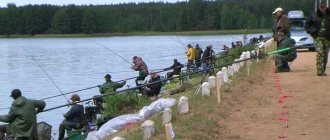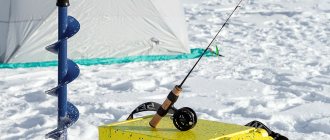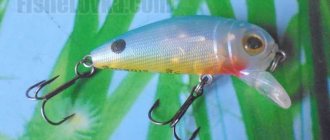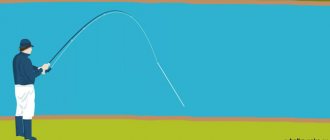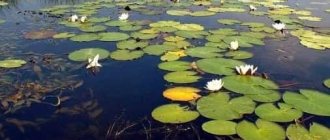Artificial front sight
represents a more or less faithful imitation of an insect or other organism in all stages of its development.
It is knitted (made) on a hook, using various feathers, hair from wild and domestic animals, multi-colored threads, synthetic materials and much more. A fly
is an artificial fishing bait. Used as bait for catching predatory fish. It is used in such types of fishing as fly fishing and spinning.
general information
Artificial fly
Live insects are, of course, an excellent bait for fish when fly fishing. But they need to be caught, stored, and most importantly, they cannot be thrown far: many of them are weak on the hook.
Therefore, they began to replace live insects with artificial ones long ago, called artificial flies.
In Russian fishing literature one can find descriptions of flies and spinners made by serfs with high skill. We had and now have masters who tie flies without any equipment, just on their hands, sitting on the river bank.
Artificial flies have many advantages over live insects: they are always at hand, they can be tied to any size, they are durable, can withstand any long cast and suffer little when landing fish. They seem to have only one drawback, namely that they are not alive, and fish do not take them under all conditions. Therefore, their scope of application is somewhat limited.
Artificial flies are usually used when fishing in fast currents, where the fish cannot see the bait in all details, where there is no time to smell and taste it. But this general rule has exceptions that are difficult to foresee. There are bites on them in still water, on a gray day, when there is a wave, when there is an abundance of fish, when several fish rush to the fly at once, when there is a strong feeding, etc.
Construction and materials
The fly is made using various feathers, hair from wild and domestic animals, multi-colored threads, synthetics and other materials. As a rule, it is crocheted directly onto a hook.
The design of a particular fly, as a rule, depends on its type, the intended object of fishing and the insect being simulated.
I. Wet flies:
- wingless (hackle wet flies): spider (spider), beetle (beetle), caterpillar (palmer);
- with wings (winged wet flies): mayfly (dun, spinner), caddisfly (sedge, caddis), butterfly (moth), May mayfly (may dun);
- nymphs;
- streamers. Popular in this group are muddler, matuka, bucktail, fly minnow, as well as flies tied from marabou feathers;
- flies used for catching sea and lake trout (lake and sea trout flies);
- salmon flies (salmon wet flies). In this group, some types can be distinguished: classic (regular), flies adapted for fishing at low water levels (low water), monoplane, Irish salmon flies;
- special baits for catching salmon and brown trout: Dee Lure, Norsk Lure, Demon, Terror, Worm Fly.
II. Dry flies :
- wingless (hackle floating flies): spider (dry spider), beetle (beetle), caterpillar (palmer), bivisible;
- with single wings (winged dry flies) or with double wings (doublewinged dry flies): mayfly (dun, spinner), caddis fly (sedge, caddis), butterfly (moth), may mayfly (dry may dun).
For wet fly fishing flies, the characteristic features are soft legs and wings laid along the fore-end.
Dry flies for fly fishing, on the contrary, should have stiff legs. This provides the fly with buoyancy. The main material for the legs is the feathers of roosters and chickens. The hard, glassy feathers of roosters are used to make dry flies, and the soft, less fatty feathers of chickens are used to make wet flies.
The method of tying the wings of a dry fly is determined by the type of insect being simulated (mayfly, caddis fly, etc.) at a certain stage of its life. Regarding the body of the fly, especially when wet, it is necessary to remember that some materials may change color when wet.
When tying fly fishing flies, it is necessary to observe not only the sizes of natural prototypes, but also certain proportions. The tail of the fly should not exceed the length of the hook (except for mayflies and spinners). The wings should be slightly longer than the length of the hook shank. The legs should be either at the level of the hook tip or slightly extend beyond it (spinners have legs almost twice this size).
The hook on which the fly is tied should be elastic, should not break, and should bend under significant tension. Sufficient sharpness of the hooks should be a prerequisite when purchasing them.
Types of flies
Types of flies Fishermen have been fishing with flies for several millennia, so there are many types and modifications of this bait. The most popular flies are the following types.
- Dry fly
. These baits are called dry because they float on the surface of the water without sinking. In most cases, they depict an insect that has fallen into the water, such as a mayfly or caddisfly. Use dry flies to catch any fish that feeds near the surface, from roach to chub. - Wet fly
. As you might guess, these flies imitate drowned insects. They fish with such baits mainly in the middle layers of water, and if you make the fly heavier, then also at the bottom. The wet fly is the most versatile. Swallowing an insect caught in the water is considered a matter of honor by both predators and peaceful fish. - Nymph
. Nymphs recreate the appearance of the favorite food of most fish - insect larvae living under water. Nymphs are used to fish in the middle and bottom layers. Typically, the more similar a nymph is to its prototype, such as a dragonfly or stonefly larva, the more effective the fishing will be. Although often the same chub or asp takes any fly indiscriminately. This happens especially often on the current, where the fish simply do not have time to inspect the fly in detail. - Streamer
. To hunt predatory fish, fly fishermen came up with a special fly - a streamer. This bait is called a fly only conditionally, since it depicts a fry. Usually streamers have an elongated body (they are crocheted on special hooks with a long shank) and quite bright colors. The streamer does not necessarily copy any specific fish; it is enough that it has outlines similar to real fry. Pike, perch, pike perch, chub, asp, ide - all these fish will not let a good streamer pass by. - Other baits
. These include imitations of mice, grasshoppers, crustaceans, etc. As a rule, the same materials are used as when tying regular flies: feathers, wool. In our north, particularly in Siberia, mice made from deer fur are very catchy. Taimen, lenok, and pike rush at them, and since the mouse is guided along the surface, it is simply impossible to remain indifferent during a violent bite.
Types and forms
Flies for catching fish are distinguished by the shape of an imitation of its natural food.
- Dry flies . These fly fishing flies imitate insects that find themselves on the water surface. These are mainly imitation of mayflies, dragonflies, gadflies, adult caddis flies, beetles, wasps and other flying insects. Fishing with this type of fly is carried out above the surface of the water.
- Wet flies . These fish-catching fly flies imitate tadpoles, fry, water bugs, leeches, bedbugs and drowned insects
Also, individual forms of flies are often distinguished into species:
- Nymphs . These baits imitate the underwater stage of insect development. From the moment the female lays eggs under water, the larvae emerge from them, and right up to the beginning of the transition to the next stage. Fishing with a “nymph” fly occurs at the very bottom. Often such flies are surrounded with lead or tungsten heads.
- Emergers . When the nymph is ready to move on to the next stage of development, it rises to the surface and freezes before hatching. Then, the insect breaks through the film and enters the adult stage. Fly fishing flies that imitate the moment of metamorphosis are called emergers.
- Streamers. These lures imitate fry and are used to catch large fish. These are the heaviest and largest fly fishing flies. They are equipped with tungsten or steel, which, when wiring, allows you to imitate the behavior of a wounded or sick fish. To deliver such streamers, a triple cast “from water to water” is used without playing in the air.
- Salmon fishing flies . They imitate small fish that Atlantic and Pacific salmon eat when entering the river. Most flies for catching salmon are fancy, they have a bright color, provoking this fish to bite.
- Sea flies . Fly fishing flies for fishing in salt water. They imitate marine invertebrates - shrimp, crabs, worms and small fish. These are the largest of the fly fishing flies, their length can reach thirty centimeters.
According to the degree of imitation of living organisms, flies differ:
- realistic - depicting a simulated insect with a high degree of similarity;
- imitation (stencil) - imitating the most important proportions and shapes of an insect or group of insects;
- fantasy flies (attractors) - have no prototypes in living nature. They provoke the fish to grab out of curiosity, the instinct of protecting the territory, or aggression;
- decorative or frame flies. Flies knitted from rare or expensive materials and not intended for fishing. “Frame” flies are demonstrated at exhibitions and knitting competitions, sold and made to order for collections.
Classification of artificial flies
There are several criteria for classifying artificial flies. Let us present them together for clarity.
- Method of using an artificial fly. The basis of classification in this case is the method of fishing, and flies are divided into two large groups - dry and wet.
- Components of an artificial fly. This is an independent method of division, since dry and wet flies can have characteristic features. Here we are talking about winged and wingless flies.
- Reproduction accuracy. We knit some artificial flies according to natural patterns (exact imitations); When knitting others, we proceed from the fact that certain shapes or colors are more attractive to fish. We call such flies fantasy.
- Entomological principle. We knit individual artificial flies to imitate specific insects. Therefore, we classify them into flies that imitate mayflies, stoneflies, caddis flies, etc.
- Practical purpose (catching fish of a certain type) When tying artificial flies, we can (primarily by size, shape, color) determine in advance what kind of fish can be caught on them. That’s why we are talking about flies for trout, grayling, asp, dace, salmon, etc.
This division, however, is not very practical for a fly tyer. It is necessary to choose classification criteria that, of course, would correspond to the given division, but at the same time would help to quickly navigate the practice of fly tying.
We must always remember that the basis of the fly classification system is entomological criteria.
Entomological division of artificial flies
Photo of the process of making flies with your own hands
Note!
Bloodworms for fishing - secrets and tricks on how to properly obtain, store and attach for catching various types of fish (125 photos + video)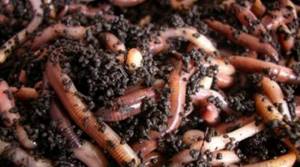
Dung worm - methods of extraction and secrets of catching. How to properly prepare and breed at home (100 photos and videos)
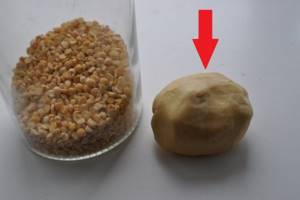
Peas for fishing - methods of preparation, catching, baiting and feeding fish (video + 125 photos)
Read here Twister: types, features, choice of bait and installation of gear. 115 photos and videos of fishing techniques for beginners
Help the project, share on social networks 

0
Fly tying
To make flies you need simple tools and materials:
- A tripod (vise)
for attaching a hook during fly tying. - Pull clamp
for fixing the free end of thread or feathers. - Hooks
, which should be light, elastic, durable. Sometimes double hooks are used. Their sizes can be different - No. 3.5 - 8, the most popular are No. 3-6. - Threads
made of natural or artificial silk. Primary colors are gray, yellow, brown, brown, white, black, less often: red, dark blue, green. - Feathers
of two types. These are narrow bristly feathers from the neck of an old rooster. The best feathers are considered to be narrow, not fastened together by bristles, with almost parallel edges. And flight feathers from the wings of various birds, best of all waterfowl. Usually, only plates cut from these feathers are used to make the wings of artificial flies. Feather color - gray, brown, brown, white, black. - Wool from
various mammals, including horsehair, for making tail appendages in mayflies and other artificial flies. To form the body and imitate various details of the fly, the hair of any other animal is suitable. - Waterproof, quick-drying glue
for attaching individual parts of the front sight and covering them with a protective layer. The glue must be transparent so that it does not change the color of the bait. The fly covered with it should remain at least a little elastic. - Other materials
- natural cork for the body base of some dry flies; medium thickness polyethylene film for transparent wings; metal foil for wrapping the body of flies, etc.
Tying artificial flies
Artificial fly tying technique
Hook No. 4-6, secured in a vice, from the ring to the beginning of the bend, and then wrapped with thread in the opposite direction (thus, 2 layers of thread are obtained). The winding should be dense and tight enough. The free end of the thread is secured with a loop and tightened with a pull-down clamp.
Then they take a piece of rooster feather 3-5 cm long. The lower end of it is attached with several turns near the ring of the hook. The attachment point can be covered with glue, but this is not necessary. Afterwards the feather is wrapped around the fore-end several times. The result is a hedgehog. For a wet fly it should be sparse, for a dry fly it should be thick.
After winding, the end of the feather remains (approximately 1.5-2.0 cm), which is pressed to the body of the fly and tightly wrapped with thread. Having cut off the excess, a tuft of bristles is left, imitating the tail appendage of a fly. The body wrapping can be continued to the desired thickness. Then several loops are made, and the thread is cut to a crew cut, covering this area with glue or varnish. If your hedgehog's bristles are too long, they can be trimmed.
To thicken the body of the dry fly (if required), use a cork rod. When the glue dries, press the bristles with your fingers to the body of the bait so that they are turned back at a certain angle.
Gadfly fly
Materials:
- hook;
- mounting thread;
- chenille;
- foam;
- refined wax;
- feather for legs;
- mesh for fly wings, burning mold;
- varnish
So, how to make a fly for fishing at home:
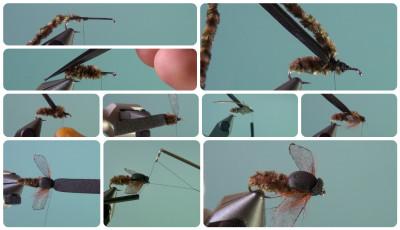
We wrap the hook shank with mounting thread in the direction of the bend.- At the bend we attach chenille, a color similar to that of the gadfly , and we tie it to the fore-end (we do not cut off the remaining part, we will still need it for the breast).
- We cut off some of the hairs at the bend of the hook, giving the body a cone shape.
- On the side of the loop (at a distance of 1/3 to the tail) we attach 2 mm in thickness and 6 mm in width.
- From the chenille that remains after the formation of the body, we make a breast. We cut off excess material.
- We rub the thread with cleaned wax so that the wings do not slide on it (there should be no lumps of wax on the thread).
- We create wings from mesh, burning them on a special form.
- We attach the wings one by one to the body of the gadfly.
- We tie a feather under the place where the wings are attached to make legs out of it.
- Wrap the feather 3 times . We press the resulting brush with a thread: it should not puff up.
- We press the foam onto the breast from above, wrap it with a thread next to the loop and cut it off, leaving a millimeter of material after the breast.
- Using a knotter we form a head for the gadfly.
- Apply varnish to the head.
Larger picture
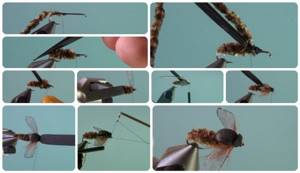
.
Botflies often end up in the water at cattle watering holes.
Cows use their tails to drive them away, often knocking the insects into the river.
The ideal place for catching chubs and other fish with gadflies is near a watering hole downstream.
Below are video step-by-step instructions for knitting a fly for fishing with your own hands.
Features of knitting different types
- The palmer
, or hairy caterpillar, is made only as a dry fly, sometimes using a cork rod. The manufacturing process itself is similar to that described above. The only difference is that the feather is selected longer (6-10 cm) and wrapped in a spiral along the entire body of the future bait. Its color ranges from brown to black, less often red-brown. - The mayfly
is produced as a dry fly only. A long, slightly curved cork rod is put on a hook No. 4-6 with a relatively long shank. 3 horse hairs or something similar are attached to it to form the tail appendage. Then they begin winding, during which 2 wings cut from a feather and a small feather are attached to the front part. The feather is wrapped in front and behind the wings, secured with thread and covered with glue. The color of the artificial fly ranges from yellow to brown. This bait is successfully used from late spring to mid-summer. - The moth
is also usually made as a dry fly. They knit it on hooks No. 3.5-5 with a medium-length shank in the same way as a universal fly, with the only difference that the moth does not have a tail appendage, but has scaly wings made of feathers. The most popular moth colors are white, brown and gray. White moth is used when fishing at dusk. - The fly
is tied on hooks No. 3.5-6 with a relatively short shank. For dry baits, a cork rod can be used. The body is formed thick and round. The wings are cut out of feathers or thin plastic film; there are few bristles. The body of the bait is usually covered with glue or varnish, as it should be shiny. The body color of flies ranges from dark gray to black or metallic blue to green. These flies are used in late summer or early autumn. - The ant
is most often made as a wet fly. Knitted on small hooks (No. 3-5) with a long shank. First, the cephalothorax and abdomen are wrapped. After this, a small feather is attached, which is used to wrap the shank of the hook several times to imitate legs. The ant's body is covered with glue or varnish. The color of the cephalothorax is usually brown (red) or black, the abdomen is dark gray, almost black. The ant is a very catchy fly, especially in early spring and autumn. - Spider
is a small fly, which is usually tied on hooks No. 3.5-5 with a short shank. Knitting is quite painstaking, since simultaneously with the formation of a rounded body, it is necessary to attach 8 thick legs made of horsehair or individual fibers of a bird feather. The color of artificial spiders ranges from red to dark gray. Sometimes there are other colors. Most often, this bait is used as a wet fly in late autumn, when the cobwebs begin to fly. - A spinner fly
is a combination of a wet fly with a tiny spinning blade. For this bait, a universal fly is often used, which is sometimes tied on a double. This bait is successfully used in fast currents. - A streamer
is a large, long wet fly that represents a whitebait. The streamer is knitted on hooks Nos. 6-8 with a very long shank or on two hooks in the standard way. 1 or 2 (on one or both sides) long feathers are attached to the top, which should cover the entire fly, while masking the hooks. Typically, brightly colored streamers are used for catching large salmon, brown trout, taimen, lenok, and trout, but this is, so to speak, a classic. In general, streamers and fly spoons are suitable for catching many fish, and they are especially good for fishing for perch, chub, ide, sabrefish, roach, rudd and bleak. - Wobblers-streamers
are feather baits with a voluminous blade, thanks to which, with accelerated retrieve, they are able to quickly sink to a considerable depth. And this despite the fact that the fluffy bait weighs only 8 g. However, when wet, it weighs twice as much and is easily cast even in a headwind. The head of the streamer is equipped with a sinker, and the fore-end, hidden in the hook feathers, is covered with a layer of lightweight floating plastic. Because of this, being in the water in a free state, the bait is in a vertical position, and with uneven wiring it not only oscillates and staggers, but also jumps, waddling from head to tail.
Flies for catching grayling, catchy models and manufacturing details
Many anglers consider grayling to be a noble fish, the catching of which requires a very scrupulous approach. Any little thing that is underestimated by a beginner will lead to a complete fiasco in fishing. Of particular interest to anglers are flies for catching grayling. Having good sharp vision, the fish instantly notices inaccuracy in the artificial bait.
It is not for nothing that grayling hunters spend a lot of time studying the food supply of fish in each area. And only after this they begin to select or manufacture imitations of insects and their larvae. What is good about the fly, and what are the weaknesses of this bait?
Advantages and disadvantages, types of artificial bait
Fishermen were forced to start producing artificial insects by problems associated with the extraction and storage of natural baits. How long does it take to dig up worms or catch insects? But how to bring them alive if the path to the “black stones” is covered in several hours.
Having taken a closer look at the insects that fish love, craftsmen began tying artificial flies. It turned out that using available materials, it is possible to successfully imitate insects and their larvae. And this is the main food of grayling. The advantages of flies include:
- versatility;
- minimum weight and dimensions;
- reliable installation on the fishing line;
- long service life;
- low costs for self-production.
As for the negative aspects, many anglers categorically do not want to engage in tying flies for grayling. There is simply not enough patience, skill in handling thread and creativity. It’s a shame to lose catchy models when bitten by a toothy predator or with a dead hook.
All baits are usually divided into two groups.
- Dry flies are designed to imitate the behavior of insects that have fallen into water. Outwardly, they resemble wasps, moths, dragonflies, flies, etc. A distinctive feature of this group is the presence of fluffy plumage. For knitting dry patterns, materials such as bird feathers, fur of domestic and wild animals are used. Hooks are selected to the minimum size from thin wire.
- Wet baits should remind the fish of insects, their nymphs, and pupae that live in the water. These are water beetles, tadpoles, caddis flies, etc. A characteristic feature of wet modifications is minimal plumage combined with thick hooks. Metal wire is often used to weight the bait.
Requirements for bait for grayling
Grayling lives in various rivers and lakes of vast Russia. In each region, fish have a certain food supply to which they are genetically accustomed. There is one more point related to the seasonal preferences of grayling.
It is hardly worth offering fish in early spring imitations of insects that appear in late summer. Flies for grayling must first of all meet these most important requirements.
If you monitor the feeding habits of this fish from spring to autumn, you can determine the necessary parameters of artificial baits.
- In spring, grayling leads a mainly bottom-dwelling lifestyle, which is explained by the absence of anything edible on the surface of the water. During this period, the fish feed on worms, mollusks, crustaceans, eggs of spawned fish, caddis flies, and stoneflies. Accordingly, it is necessary to select a nymph for catching grayling that will resemble natural food, both in appearance and in behavior in the water. Most spring baits should be sinking. At the end of spring, a mass emergence of the mayfly butterfly begins in many rivers. At this point, the angler should prepare an artificial copy of the mayfly. The fly is made in a dry design, and the fly line is installed as a floating type. If you miss the moment of departure, then later it will be problematic to seduce grayling with such a model.
- In summer, you have to look for grayling in small rivers and pools, where there are deep areas after rapids. Trophy specimens are very rare to come across in hot weather. The main food in summer are insects such as ants, amphipods, flies, butterflies, and dragonfly larvae. To guess what grayling eats, experienced fishermen use gear that allows them to simultaneously cast 5-6 leashes with different baits. As soon as a fish is caught on one of the flies, the remaining baits can be gradually replaced with a more catchable variety.
Be careful!
In each area, the same insects may differ in color. Even this nuance must be taken into account when selecting or making bait.
- Autumn is considered one of the most productive seasons of the year for grayling fishing. Of all the insects and larvae that fish feed on at this time, the grayling likes the caddisfly the most. If the imitation turns out to be realistic, then the fish will bite both in cloudy weather and in the dazzling sun.
The best flies
It’s hardly worth blindly trusting numerous ratings of flies for grayling. While foreign fish are really attracted to these baits, our grayling is wary of them. It is better to evaluate the performance of the bait based on its similarity to natural food.
- Most anglers prefer flies that imitate caddis flies. This type of bait can be used both on mountain rivers and on Karelian lakes. The imitation works properly throughout the open water season. Although the caddisfly copy is small in size, the bait adheres well to the surface and accurately repeats the movements of a natural insect.
- In the spring, there is no equal to a fly that imitates an emerging mayfly. Once the insects fly out, the angler can count on a good bite in any weather. Bycatch may include fish such as whitefish and small taimen.
- The nymph attracts the attention of grayling in summer. When the fish concentrates in the middle horizon or near the bottom, the sinking bait is confidently attacked by grayling. The nymph gives good results throughout the fall until freeze-up.
- Universal baits that can be used to catch grayling from spring to autumn include imitation bunting larvae. In the classic version, the fly is attacked by whitefish, chebak, trout and ide. It is important to guess the color scheme at a certain time.
- The caddis fly pupa is perfect for hunting trophy prey. Such a fly can be placed on a regular float rod, letting it go with the flow. Most often, bites occur at the end of the riffle, where there is a quiet pool.
How to tie a catchable fly
Tying a simple fly is not that difficult. For work you will need a small vice, scissors and tweezers. The materials you should prepare include wool and feathers, thin threads, diving, beads, a sharp hook and waterproof glue.
- A hook is inserted into the vice, onto which the bead clings. She will play the role of the head.
- The backing is formed with black thread, starting from the bead and ending with the bending point of the forearm.
- To make a tail you need a piece of bird feather. Four barbs are applied to the hook and wrapped with thread up to the head of the fly. The excess feather is trimmed off around the bead. The thread is wound in the opposite direction.
- The body of the fly is formed from diving, which is first wrapped with thread, and then even turns are made in one or two layers on the hook.
- By attaching a feather from a decorative rooster, the wattles are pulled away from the head, after which the front part is fixed with a thread. Now the feather and thread are wrapped 2-3 times around the hook. The thread is wound in the area of the head.
- The excess feather is cut off.
To prevent the thread from coming undone, it is treated with glue. Photo 3. Do-it-yourself finished fly.
Mounting the fly on the fishing line
When a fishing method has been chosen and a catchy fly has been made, it’s time to learn how to tie the fly to the fishing line. To do this, you can use one of the reliable nodes, for example, a Uni node.
- The fishing line is threaded into the ring of the fly hook from the outside, a piece about 20 cm long is applied parallel to the main thread.
- A loop is made from the segment below the base. The end of the fishing line is wound inside the loop, wrapping both threads.
Attention!
When wrapping the double line, you should get at least 5 turns.
With the right choice of fly and precise determination of the grayling's parking spot, catching the fish will remain a matter of technique. Let the bait float with the current until it disappears at the moment of the bite.
Source: https://fishelovka.ru/fish/obzor-ulovistyh-mushek-na-hariusa-magazinnye-i-samodelnye-modeli
Fly fishing
Fly fishing with a fly If you are planning to fly fish for the first time, you should understand how different situations affect the behavior of insects.
For example, when falling on water, insects make every effort to fly up. However, often their active floundering in the water has a radically opposite effect - the wings and body of the insect become wet, and it dies.
Catching fish with a fly involves “falling” an artificial fly onto the surface of the water, at this time the fisherman must not yawn - the fish will bite immediately, because it is waiting for its prey. Even in the absence of a bite, the fisherman must continue to move the fly through the water - this will provoke the predator instinct of the fish.
If the fly lies on the surface of the water without moving, there can be no talk of any bite. One of the most common methods of fly fishing is fly fishing. With this fishing method, the wiring usually consists of suspenders. What does it mean? You need to tighten the fishing line by 12-20 centimeters, walk a little along the shore and tighten the fishing line again, and so on. Moreover, such pull-ups must be done without jerking, at equal time intervals, so as not to spook the fish. Very often, fishermen use another method: they try to slide the fly along the water surface without stopping, only occasionally twitching it, thus imitating a drowning insect.
Do it yourself
If desired, artificial bait can be easily made at home. In this process you cannot do without the following materials:
- vice;
- pen holder;
- scissors;
- knotweed;
- a set of needles;
- bobbin thread holder;
- threader;
- tweezers;
- brushes for painting with paints or varnish base;
- hooks;
- mortars;
- lamps;
- mirrors;
- magnifying glasses;
- mounting thread;
- feathers (preferably rooster);
- dabbing;
- wool and lurex
.
Making a dry type fly
For DIY production, it is recommended to use bright orange and black hairs about 5-6 cm long.
Workflow steps:
- Remove the hook from the spoon.
- We thread the bright hairs through the ring. You can securely fix the material using a cambric. To do this, we put it on the hook ring that will be used.
- Using an ordinary needle, we fluff the fly.
- The product is ready for use.
Knitting a nymph
- Having previously prepared a size 5 hook, we secure it with a vice.
- We wind the mounting thread in a dark tone.
- Using dark brown dabbing we form the body of the insect, constructing the head and thorax.
- After wrapping the abdominal area, we leave a free part of the fur to copy the tail appendages.
- The tip of the gray feather is fixed by tying a thread near the ring. After making a few turns, we secure the mounting thread.
- We cut off the excess part of the winding using scissors.
Making a cargo front sight
- We prepare hooks numbered 6 and 7 (their shape should be curved as much as possible).
- Galvanized steel wire (0.35 mm) is placed on the shank of the hook (along the curved edge).
- The long part of the tip should hang freely near the bend of the hook, and the other end should protrude slightly beyond the eye.
- The wire wound around the hook is firmly wound with cotton type thread. Winding is carried out in one layer to the middle part of the forend. From the beginning of the ear you should make an indent of about 1 mm.
- To avoid loosening the thread, it is recommended to press it firmly against the hook.
- The short part of the tip of the wire must be bent in the opposite direction and fixed as firmly as possible to the forend.
- After this, be sure to check for free space near the eyelet on the forend. This area will become part of the structure of the insect's small head.
- After attaching the wire folded in half , we wrap the tip of the product from which the bait will be made on top of the material.
- After knitting the body of the insect, we construct a hook-hook. For these purposes, the long part of the steel wire is bent at an angle of 45 degrees. During this stage of work, it is imperative to maintain a 2 mm indent from the bottom of the insect’s body.
- Using scissors, carefully cut off the remaining wire , leaving a couple of millimeters for the tail area.
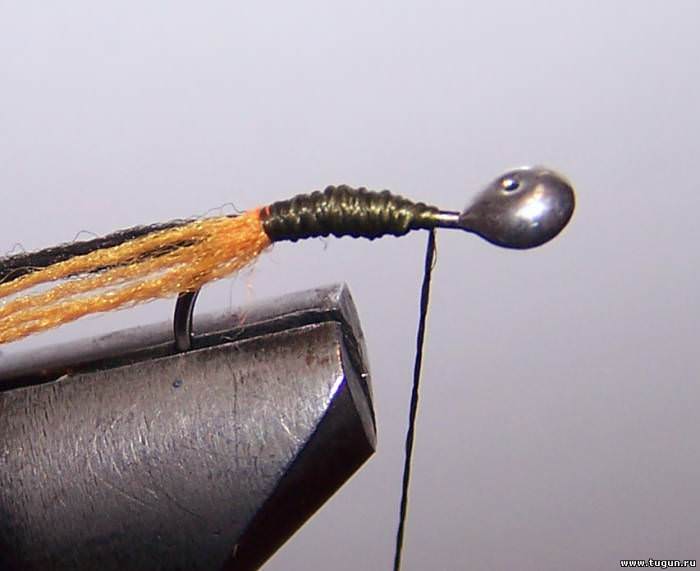
A catchable version of the Sayan type fly
- Having bent the shank of the hook, we slightly unbend the hook. These manipulations will make the hook as similar as possible to the Japanese look.
- Stepping back 2 mm from the shoulder blade , we tie the leash.
- We wrap the nodal area with thread and glue it with an adhesive base (BF-2).
- It is very important to observe the direction of the leash towards the location of the sting (perpendicular to the fore-end).
- the end part of the hook with the spatula with black thread.
- The top of the thread is coated with a varnish base. The insect head is ready!
- Let's start winding the body. To do this, a bright yellow or orange thread is wound around the forend, which will serve as the belly.
- Let's start tying the plumage (should be on the side where the sting is located). This feature allows the fly to remain very stable in the reservoir, despite the speed of the current and gusts of wind.
Dry flies: manufacturing principle
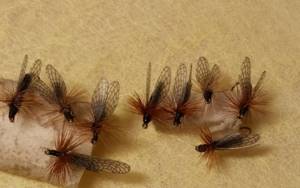
Even an inexperienced angler can make a dry fly. Before starting work, prepare:
- several five-centimeter threads of wool (bright or dark color);
- fishing hook with spoon;
- tweezers;
- cambric.
When the materials and tools are ready, you can begin making a dry fly:
- Remove the hook from the spoon.
- Pull the wool threads through the head and then secure them with cambric.
- Fluff the body of the bait. This is best done with tweezers.
Important: the finished bait fly must be tested by lowering it into water.
Dry fishing flies are perfect for catching pike, perch or chub. It's best to make several lures at once, in case you have to cut the line.

